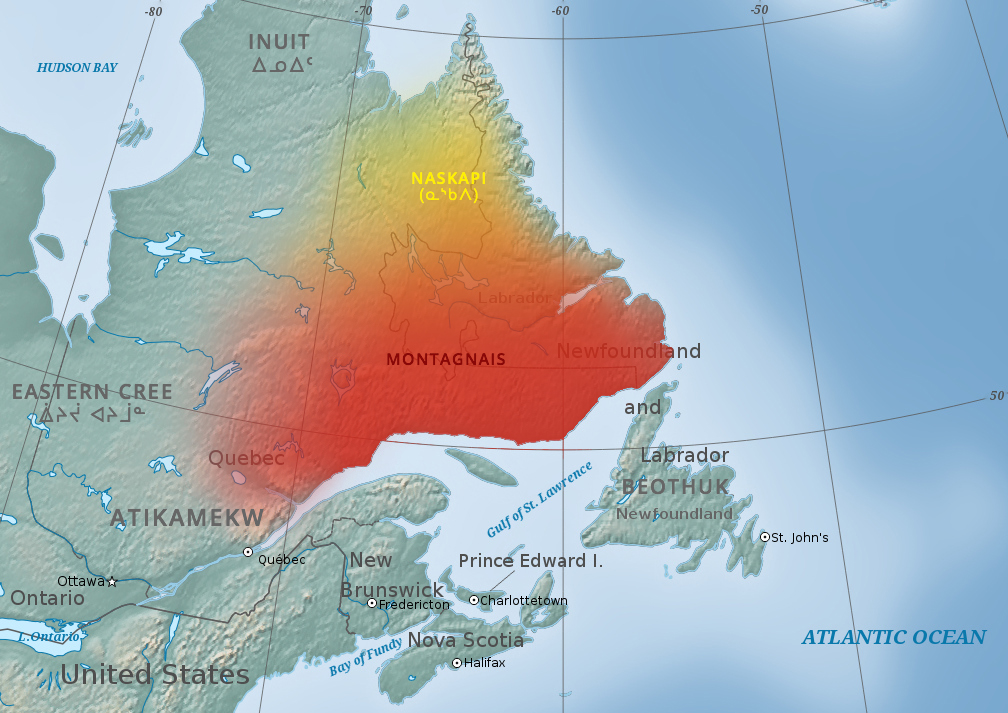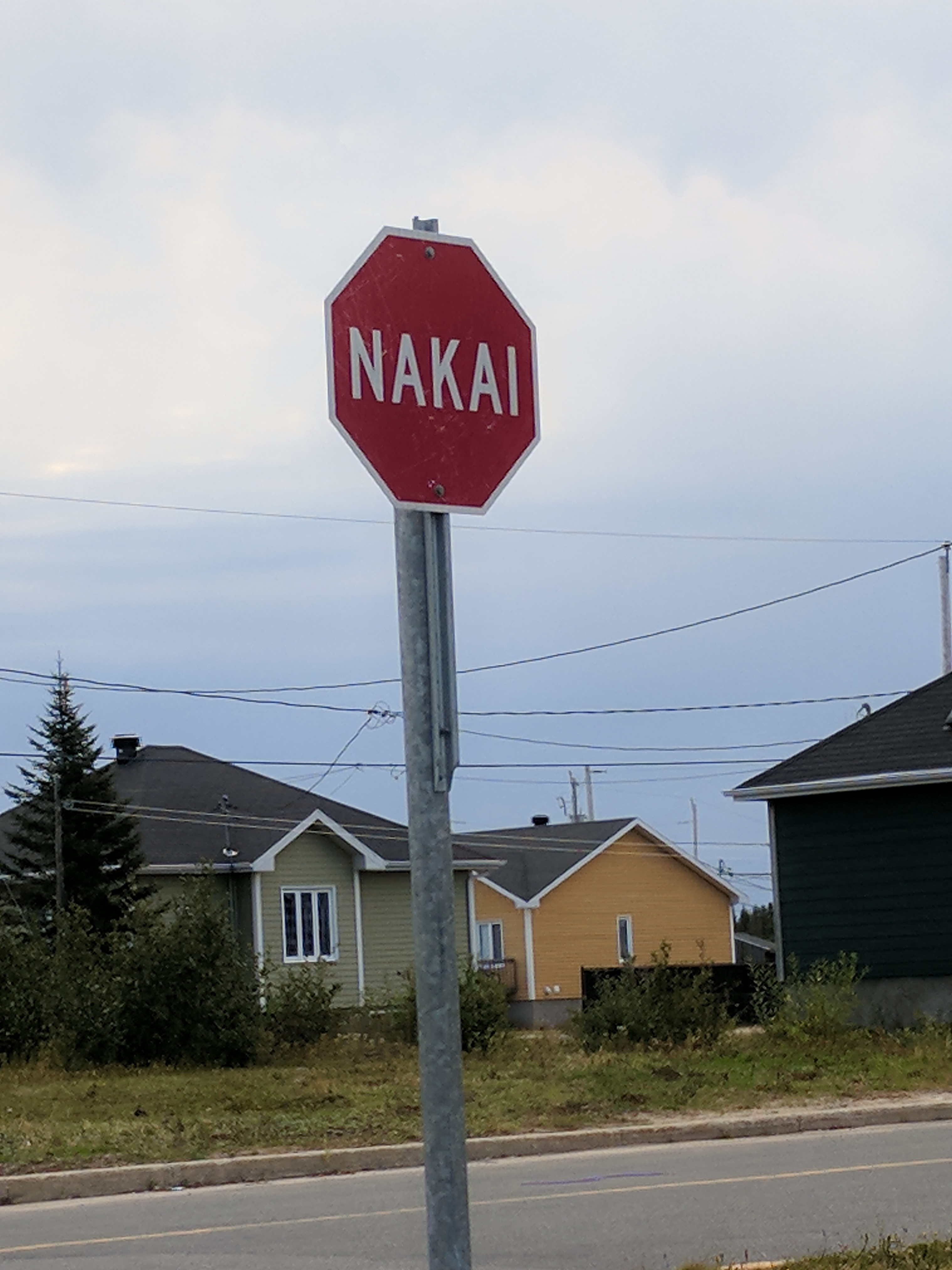|
Matimekosh, Quebec
Matimekosh (or Matimekush, officially Matimekosh 3) is a First Nations reserve on Lake Pearce in the Côte-Nord region of Quebec, Canada. Together with the Lac-John Reserve, it belongs to the Innu Nation of Matimekush-Lac John. It is an enclave in the centre of the Municipality of Schefferville, and geographically within the Caniapiscau Regional County Municipality but administratively not part of it. ''Matimekosh'' means "small trout". Matimekosh is only accessible by airplane via the Schefferville Airport or by train via Tshiuetin Rail Transportation from Sept-Îles. It is serviced by a nursing station, community radio station, library, arena, community centre, and an aboriginal police force, while water, sewer, and fire protection services are provided by the municipality of Schefferville. History The region was regularly visited by Innu indigenous people for hunting and trapping, but they did not permanently reside there. Because of mining development in the early 1950s, s ... [...More Info...] [...Related Items...] OR: [Wikipedia] [Google] [Baidu] |
Côte-Nord
Côte-Nord (, ; ; land area ) is the second-largest administrative region by land area in Quebec, Canada, after Nord-du-Québec. It covers much of the northern shore of the Saint Lawrence River estuary and the Gulf of Saint Lawrence past Tadoussac. While most of the region is in the same time zone as the rest of Quebec, the far eastern portion east of the 63rd meridian, excluding the Minganie Regional County Municipality, is officially in the Atlantic Time Zone and does not observe daylight saving time. Population At the 2016 Canadian Census, the population amounted to 92,518, approximately 1.1% of the province's population, spread across 33 municipalities, various Indian reserves and a Naskapi reserved land. The towns of Baie-Comeau and Sept-Îles combined amount to a little more than half of the population of the region. Geography and economy Côte-Nord was created as an administrative region in 1966. Important landmarks of Côte-Nord include Anticosti Island, the Ming ... [...More Info...] [...Related Items...] OR: [Wikipedia] [Google] [Baidu] |
Innu
The Innu / Ilnu ("man", "person") or Innut / Innuat / Ilnuatsh ("people"), formerly called Montagnais from the French colonial period (French for "mountain people", English pronunciation: ), are the Indigenous inhabitants of territory in the northeastern portion of the present-day province of Labrador and some portions of Quebec. They refer to their traditional homeland as ''Nitassinan'' ("Our Land", ᓂᑕᔅᓯᓇᓐ) or ''Innu-assi'' ("Innu Land"). The Innu are divided into several bands, with the Montagnais being the southernmost group and the Naskapi being the northernmost. Their ancestors were known to have lived on these lands as hunter-gatherers for several thousand years. To support their seasonal hunting migrations, they created portable tents made of animal skins. Their subsistence activities were historically centred on hunting and trapping caribou, moose, deer, and small game. Their language, Ilnu-Aimun or Innu-Aimun (popularly known since the French colonial ... [...More Info...] [...Related Items...] OR: [Wikipedia] [Google] [Baidu] |
Schefferville
Schefferville is a town in the Canadian province of Quebec. Schefferville is in the heart of the Naskapi and Innu territory in northern Quebec, less than 2 km (1¼ miles) from the border with Labrador on the north shore of Knob Lake. It is located within the Caniapiscau Regional County Municipality and has an area of . Schefferville completely surrounds the autonomous Innu community of Matimekosh, and it abuts the small community of Lac-John Reserve. Both of the latter communities are First Nations Innu reserves. Schefferville is also close to the Naskapi reserved land of Kawawachikamach. The isolated town is not connected to the provincial road network but is accessible by airplane via the Schefferville Airport or by train. Schefferville is the northern terminus of Tshiuetin Rail Transportation (formerly operated by the Quebec North Shore and Labrador Railway) with service to Sept-Îles. McGill University operates the McGill Subarctic Research Station in Schefferville. ... [...More Info...] [...Related Items...] OR: [Wikipedia] [Google] [Baidu] |
Canada 2016 Census
The 2016 Canadian census was an enumeration of Canadian residents, which counted a population of 35,151,728, a change from its 2011 population of 33,476,688. The census, conducted by Statistics Canada, was Canada's seventh quinquennial census. The official census day was May 10, 2016. Census web access codes began arriving in the mail on May 2, 2016. The 2016 census marked the reinstatement of the mandatory long-form census, which had been dropped in favour of the voluntary National Household Survey for the 2011 census. With a response rate of 98.4%, this census is said to be the best one ever recorded since the 1666 census of New France. This census was succeeded by Canada's 2021 census. Planning Consultation with census data users, clients, stakeholders and other interested parties closed in November 2012. Qualitative content testing, which involved soliciting feedback regarding the questionnaire and tests responses to its questions, was scheduled for the fall of 2013, w ... [...More Info...] [...Related Items...] OR: [Wikipedia] [Google] [Baidu] |
Iron Ore Company Of Canada
Iron Ore Company of Canada (often abbreviated to IOC) (french: Compagnie Minière IOC) is a Canadian-based producer of iron ore. The company was founded in 1949 from a partnership of Canadian and American M.A. Hanna Company. It is now owned by a new consortium, including the Mitsubishi and Rio Tinto corporations. Rio Tinto is the majority shareholder in the venture, with 58.7% of the joint stock as of October 2013. Mitsubishi controlled 26.2% of the investment as of March 2013. Based in Montreal, Quebec, IOC currently has mining and concentrator operations in Labrador City, and operates the Quebec North Shore and Labrador Railway to ship ore concentrate from the mines, such as Wabush, to the port of Sept-Îles, Quebec. Currently, this railway (along with the TSH, CFAQ, and WABL lines) form an isolated railroad network, as it does not interchange with any other rail lines on the North American network. During 1977 to 1983, the president of the company was Brian Mulroney ... [...More Info...] [...Related Items...] OR: [Wikipedia] [Google] [Baidu] |
Kawawachikamach, Quebec
Kawawachikamach ( nsk, script=Cans, ᑲᐛᐛᒋᑲᒪᒡ, translit=Kawâwâchikamach) is a Naskapi/Iyiyiw First Nations reserve and community at the south end of Lake Matemace (where it joins Lake Peter), approximately northeast of Schefferville, Quebec, Canada. It belongs to the Naskapi Nation of Kawawachikamach. The village was built by the Naskapi/Iyiyiw from 1980 to 1983. The language spoken is Iyiyiw-Imuun, a dialect closely related to Innu and Iynu (East Cree). The name means "the winding river". Access to the village is by way of Schefferville Airport or railway from Sept-Îles to Schefferville, then by way of a road from the centre of Schefferville. With the demise of Schefferville as a residential centre for the iron ore mining operations, Kawawachikamach and Matimékush are now the main communities in the region. Telephone and postal services are provided from the Schefferville exchange by Telebec and from the Schefferville Post Office, while electricity is provi ... [...More Info...] [...Related Items...] OR: [Wikipedia] [Google] [Baidu] |
Uashat-Maliotenam
Innu Takuaikan Uashat Mak Mani-Utenam is an Innu First Nations band government in Quebec, Canada. It is based in Sept-Îles in the Côte-Nord region on the North shore of the Saint Lawrence River. It owns two reserves: Maliotenam 27A and Uashat 27 located at both ends of Sept-Îles. It is governed by a band council and is a member of the Mamuitun Tribal Council. Population , the band has a total registered population of 4,781 members. According to Statistics Canada's 2016 Canadian Census, Uashat had a population of 1,592 up 7.2% from 1,485 found in the 2011 Census. Maliotenam had a population of 1,542 in 2016, up 17.2% from 1,316 in 2011. Politics The Nation is governed by a chief and band council of six members. For the 2019–2022 tenure, the chief of the band council of Uasuat-Maliotenam is Mike (Pelash) McKenzie. The Innu of Uashat-Maliotenam and those of Matimekosh-Lac-John are represented in land claims negotiations by the ''Corporation Ashuanipi''. Languages The ... [...More Info...] [...Related Items...] OR: [Wikipedia] [Google] [Baidu] |
Kuujjuaq
Kuujjuaq (; iu, ᑰᑦᔪᐊᖅ, i=no or iu, ᑰᔾᔪᐊᖅ, i=no, label=none, "Great River"), formerly known as and by other names, is a former Hudson's Bay Company outpost at the mouth of the Koksoak River on Ungava Bay that has become the largest northern village ( Inuit community) in the Nunavik region of Quebec, Canada. It is the administrative capital of the Kativik Regional Government. Its population was 2,668 as of the 2021 census. Names Kuujjuaq was founded as Fort Good Hope in 1830 but in 1831 changed its name to Fort Chimo, an anglicization of an Inuit language word , meaning "Let's shake hands" and also likely to avoid confusion with Fort Good Hope operated by the Hudson's Bay Company (HBC) in the Northwest Territories. As this was a common greeting locals used with the HBC fur traders, they adopted it as the name of their trading post. A fictional account of this naming is given in the 1857 novel ''Ungava'' by R. M. Ballantyne, where it is taken f ... [...More Info...] [...Related Items...] OR: [Wikipedia] [Google] [Baidu] |



